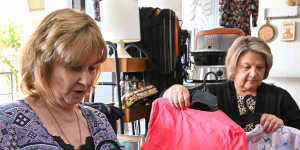Community hubs delivering affordable,high-quality goods. Fundraising centres. And eclectic treasure troves full of lucky finds. At least,they used to be.

The story of how fast fashion ruined op shops is obvious and hazy in equal parts.Joe Armao
Where you once might have scanned the racks and nabbed a perfectly preserved British-made trench coat or well-mended pair of French pumps,now you’re lucky to grab a misshapen synthetic T-shirt for less than you could buy it new.
“I call that getting Anko’d,” says 33-year-old writer Hannah Scholte,referring to the disappointment of thinking you’ve seen a vintage gem and discovering it’s just old Kmart.
The fall of op shops
Scholte is a second generation op shopper. She grew up scouring second hand spots with her mum and always appreciated how they allowed her to dress creatively on a budget,while lessening the environmental impact of buying new. That thrill has dulled.
“I’ve noticed so much of the clothing in your average op shop has really shifted towards mass-produced,low-quality fast fashion,” she says.
Mel,a 34-year-old costume buyer for film and TV,who has chosen not to share her surname for privacy reasons,has similar frustrations. She visits op shops daily for work,but explains that “as a teenager and young adult about 80 per cent of my wardrobe was purchased from the op shop”.
Back then it wasn’t just about fashion – it was a financial necessity. “When I moved out of home they were literally the only way I could afford a warm wool coat … even 15 years ago,before fast fashion really took off,I found a lot of the second hand items were better quality.”
Today,Mel wonders if her younger self would get so lucky. Looking for similar savings all she sees is “an insane amount of Anko,Shein,Zara and Valleygirl”.
Shoppers aren’t the only ones feeling the negative influence of fast fashion. “Donations have changed in quality,” says Samantha Arthur,the marketing and media coordinator for Sacred Heart Mission.
Arthur has worked in this space for over 12 years,starting out as a volunteer and spending eight years as a retail staff member. “Today it’s more fast fashion – cheap Temu,Kmart and Shein products that are low quality and produced to have a short life,” she says.
Made quickly and cheaply from petrochemical-derived synthetic fibres such as polyester,nylon,acrylic and elastane,these donations were never designed for a second life. After a handful of wears they’re usually already discoloured,shapeless and unappealing.
“No one wants to buy something that’s falling apart,stained,pilling and smells,even from an op shop,” said sustainable fashion consultant and author Lucianne Tonti. “Especially when you can buy new clothes for so little.”

Samantha Arthur has seen op shop change a lot in the past decade.Wayne Taylor
The fast fashion flood
The story of how fast fashion ruined op shops is obvious and hazy in equal parts. “Since the 2000s we’ve seen an influx of high-street brands flooding the Australian market and markets all over the world,” says Tonti. “And now that we’re two decades into fast fashion being more and more accessible,we’re seeing[those garments] filter through to op shops.”
Unfortunately,that situation shows no sign of slowing down. Australians are already among the largest consumers of fashion globally. The Australian Fashion Council have reported that per person,we purchase almost – or 56 new items – a year. “We’re buying 60 per cent more now than we were in the year 2000,and that’s expected to double again by the year 2030,” says Tonti.
On an individual level,the more we buy,the more we offload. But less visible is the habit of fast fashion retailers using second hand shops as dumping grounds.
Dropping quality and rising prices
At a glance,this may appear to be a kindness. And with the fashion council adding that we each annually throw out an average of 10 kilograms of clothes,donations do seem like the better option. But these mountains of garments are making life hell for op shops.
“We’re seen as recycling hubs for communities,” says Arthur. “When you go through a bag of donations,typically 60 per cent will be unsaleable – dirty,stained or damaged. We don’t throw out this stuff,we recycle it as best we can. But the more time we take to recycle and deal with our waste responsibly,the more our time is being eaten up.”
Bloom Op Shop founder Zara Duffy has found solutions to these issues by working with a textile recycling service that converts unwearable clothing into usable items. But even with these innovations,op shop employees are left to manage a high percentage of fast fashion donations. “Due to this rise,op shops are spending thousands on waste management,which contributes to an increase in their expenses”,says Duffy.

Op shops were once goldmines of fashion history,delivering affordable and high-quality goods.Louise Kennerley
Those additional staff hours and costs also drive up prices. Which is why op shops are often forced to sell worn-out fast fashion for more than it would retail new.
“In a lot of cases,it really is just cheaper to do a Shein haul or go to Kmart,” says Mel. “If I had a dollar for the number of times I’ve witnessed people putting items back in disgust when they’ve looked at labels and then the prices,I’d be able to afford a deposit on a house.”
Consequences beyond the sales floor
For all that effort,it’s estimated that onlyof donations are able to be sold. The rest are shipped overseas to secondhand textile markets in countries including India,Bangladesh,the United Arab Emirates and Ghana.
“People in Ghana’s Kantamanto market will buy a bail of garments they haven’t seen,” Tonti says,referring to one largest secondhand clothing markets in the world. “When they’re opening each bail about 40 per cent of it is unusable. Of the discarded clothes,what they’re buying is half trash and it’s landing them in debt.”

Kantamanto market in Accra,Ghana,where vendors commonly sell secondhand clothing.IMF Photo/Andrew Caballero-Reynolds
The decline of op shops is depressing,but it can serve as a wake-up call to the average consumer about the problematic legacy of their clothes. Because while most of us broadly understand the issues with fast fashion,few have to sit with it every day. We aren’t in Kantamanto market or walking along anwaste. But,in a much smaller way,we are witnessing this pollution ourselves.
“It can be a confronting seeing such a tangible marker of the problem of fast fashion – not in a documentary examining the bigger problem but in a regular,everyday part of my week,” admits Scholte.
How to save op shops
To get fast fashion out of op shops,we first need to get it out of our wardrobes. That means not only buying less and better,but calculating the afterlife of clothes from the start.
When purchasing something don’t only ask:Do I need this? Who made it? What materials went into its construction? Also consider:How long will it last? Could it have a life beyond me? Would I buy this myself from an op shop?
“If anything,seeing the flood of fast fashion into op shops has only made me stand my ground on avoiding cheap new clothing as I don’t want to contribute to the bigger problem at play here,” says Scholte.
For people like Scholte,Tonti has some closing advice for how to do their part.
“What we want to do is turn off that little dopamine machine inside us that’s desperate for a hit of something new all the time and sit with the clothes we already have,” says Tonti.
“Get them repaired,get them altered,really enjoy wearing them – lean into that idea that we have enough. Because we’re not going to second hand shop our way out of this mess.”
Make the most of your health,relationships,fitness and nutrition with our Live Well newsletter. every Monday.